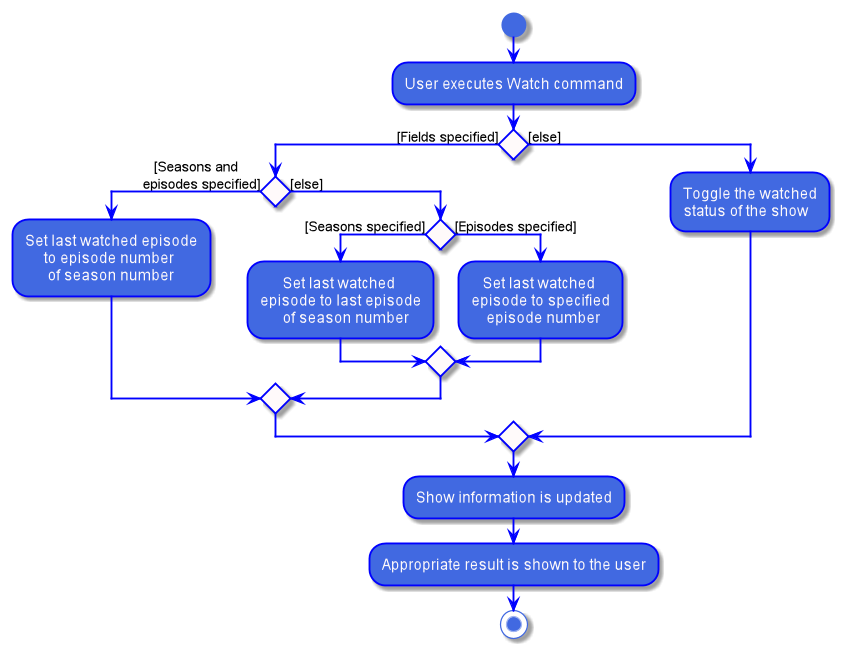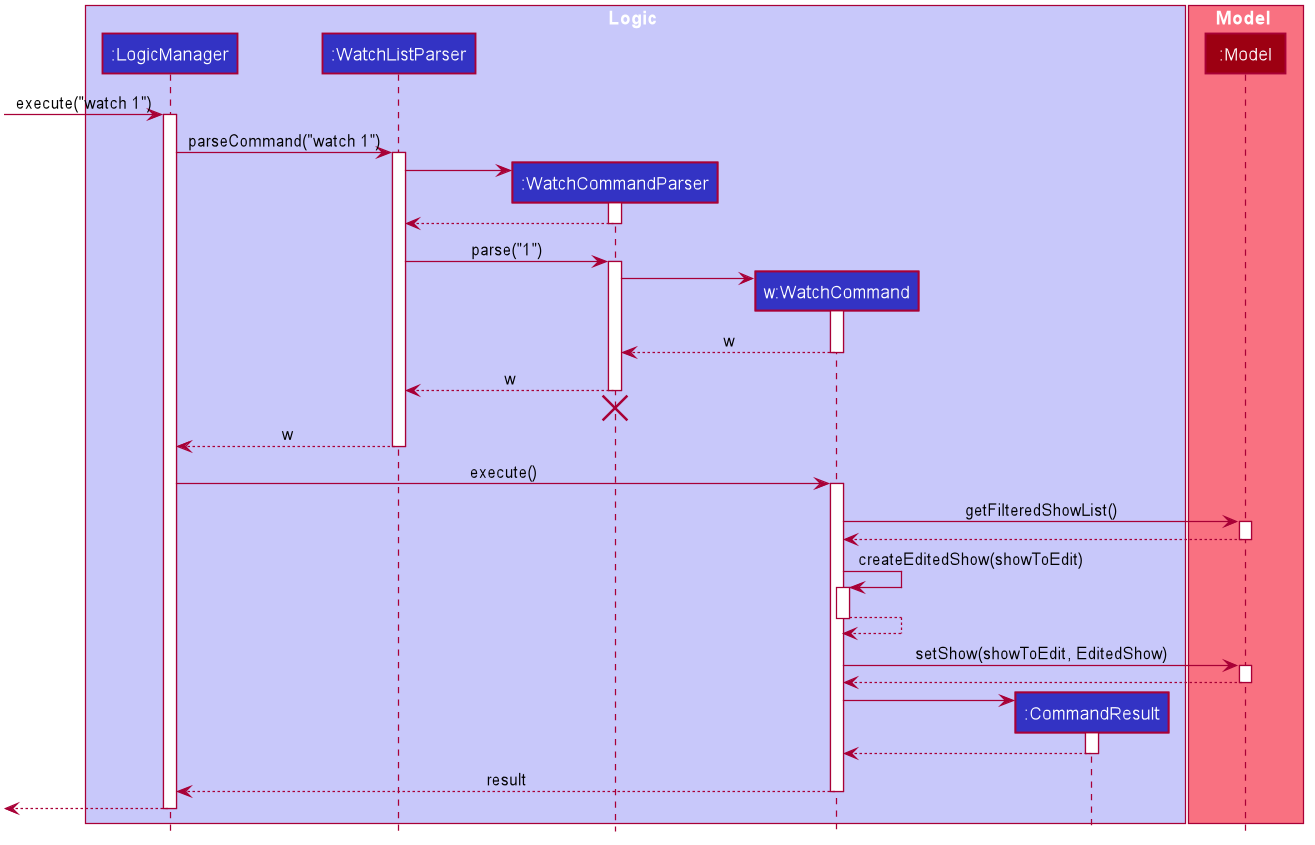This document serves to show the various contributions that I have made in the development of EzWatchlist in a concise and understandable manner.
More About The Project
EzWatchlist is a desktop application that allows forgetful users to keep track of movies and tv series that they want to watch or have watched. It was developed by a group of 5 students from the National University of Singapore taking the Software Engineering module including myself under the premise that we had to either optimize or morph an existing AddressBook application. We chose the latter. Another constraint was ensuring that the application has a command-line interface, which means that all commands should be executable through typing. The picture below shows the various components of EzWatchlist.

Main Features
-
Adding, editing and deleting shows
-
Keeping track of shows and episodes that are watched
-
Online search and syncing of shows
-
Statistics about user’s watchlist
Role
I was tasked with ensuring integration of the features of EzWatchlist. This means that I had to ensure that the commands work with one another well and perform their expected functions in the respective pages. This was a challenge since our application uses 4 different tabs, each with their unique functions and list of shows, so the implementation of the commands would vary from tab to tab.
Interpreting Symbols
The table below shows a summary of the symbols used and their respective meanings.
| Symbol | Meaning |
|---|---|
|
Commands and Components of the Project |
Tips for the user |
|
Additional information |
Summary of Contributions
This section provides an overview of the contributions that I have made to the development of EzWatchlist. It also showcases some of my coding and documentation abilities, and the challenges I faced during the development of EzWatchlist.
Major Contributions
Implemented the watch feature
What it does
The watch feature allows users to update their watch list if a show has been watched.
It also helps users to keep track of where they are in a TV series in terms
of seasons and episodes.
Justification
The watch feature enables users to keep track of shows that they have and have not watched so that they can plan
out what they want to watch in the future.
Highlights
This enhancement resulted in a need to change the storage structure of the shows to include the episodes and tv seasons. Its implementation was a challenge since it required structural change of the show objects, splitting them into movies and tv shows. The addition of the clickable checkbox to mark or unmark shows also increased the difficulty of the implementation.
Minor Contributions
-
Separated the the watchlist into different sections (not watched and watched).
-
Changed the storage structure of the shows to save them as either movies or tv shows. This feature was implemented with the intention of possibly retrieving season and episode details future versions.
Code Contributions
View my code contributions here.
Other Contributions
| #Numbers represent pull requests to the mentioned contributions. These links show the code that has been contributed to the team project |
Project Management
Enhancements to Features:
Documentation:
Community:
Tools:
-
Set up Travis Continuous Integration
Contributions to User Guide
This section serves to showcase my contributions to the User Guide, as well as my ability to write documentation for users in a concise and understandable manner. It also shows my ability to use asciidoc and markup language for formatting.
Mark/Unmark as watched : watch
To mark an unwatched show in the watchlist as watched, use the command format listed below.
Format: watch INDEX [e/EPISODE_NUMBER] [s/SEASON_NUMBER]
Before marking TV show’s seasons and episodes, you may want to use the sync
command to ensure that the TV show’s season and episode details are up to date.
|
Example Usage:
-
You want to mark "The Office" in the watchlist page as watched. Navigate to the watchlist by clicking on the watchlist tab or hitting the keyboard shortcut
1.

-
Enter
watch 1into the command box in the watchlist tab.

-
You may now view the show under the watched tab by clicking the watched tab or hitting the keyboard shortcut 2.

Alternatively, you may click on the watched checkbox to toggle between whether a show is watched as indicated by the red arrow in the image below.

Using the watch command on an already watched show will un-mark the show as watched.
|
watch would only work in Watchlist page and Watched page.
|
Examples:
-
watch 1
Marks/un-marks the first show of the list as watched. -
watch 2 e/20
Marks the first 20 episodes of the second show of the list as watched. -
watch 2 s/5
Marks all episodes of the first 5 seasons of the second show as watched. -
watch 3 s/5 e/2
Marks all episodes up to and including the second episode of the fifth season of the third show in the list as watched.
Contributions to Developer Guide
This sections showcases my contribution to the EzWatchlist Developer Guide. It exhibits my ability to use diagrams and technical terms to inform other developers of how the features were implemented and the possibility for enhancements.
[Feature] Mark/Unmark as Watched Feature
The watch feature allows users to mark or unmark shows as watched. It also allows users to keep track of the latest episode of a TV series that they have watched.
Implementation
The mark/unmark as watched mechanism is facilitated by WatchCommand which can be found under the commands package.
It extends Command and uses the WatchCommandParser to process the command entered by the user.
Given below is an example usage scenario and how the mark/unmark as watched mechanism works at each step.
Step 1. The user launches the application, and executes watch 1 s/2 e/3 command to update the latest watched episode of the first show in the list.
Step 2. Entering the command calls WatchListParser#parseCommand(), which in turn returns a new WatchCommandParser and the WatchCommandParser#parse() command is called.
Step 3. A new WatchCommand is created, with the index of the show being parsed as a field of the WatchCommand. A new WatchShowDescriptor is also created to relay the episode number and season number to the WatchCommand object.
Step 4. The WatchCommand#execute() method is called, referencing the current model, and the show that is in the current FilteredShowList is referenced based off the current model.
If the index is out of bounds, a new CommandException is thrown.
|
Step 5. A copy of the show is created through the use of WatchCommand#createEditedShow(), with the new total number of seasons and episodes updated if there are any changes.
A new isWatched value of the show is also determined based on the number of episodes that are watched.
The following activity diagram below summarizes the calculation of the number of episodes watched:

Step 6. The show in the current show list is updated to the newly created copy with the updated watched status and latest episode watched, and a CommandResult with the new watched status of the show is created.
The following sequence diagram shows how the watch operation works:

Design Considerations
Aspect: Creating a new WatchCommand instead of an altered EditCommand
-
Alternative 1 (current choice): Creating a new
WatchCommandclass for changing the 'watch' status of a show.-
Pros: Enables for greater cohesion since there is a specific command for editing the 'watch' status of a show.
-
Cons: Requires longer code, and the code is also repetitive since its implementation is similar to that of the
EditCommand.
-
-
Alternative 2: Use the
WatchCommandParserto create a newEditCommandobject that edits the watch status of the show.-
Pros: Less code repetition and shorter code in general.
-
Cons: This will mean that there is less cohesion of the code and greater dependencies since more classes depend on the
EditCommandclass.
-